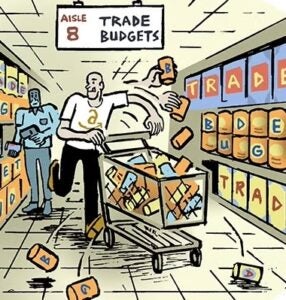 “Data-Driven Thinking” is written by members of the media community and contains fresh ideas on the digital revolution in media.
“Data-Driven Thinking” is written by members of the media community and contains fresh ideas on the digital revolution in media.
Today’s column is written by Marcus Pratt, vice president of insights and technology at Mediasmith.
In the world of ad tech, analogies are easy to find. They help make complicated matters easier to understand, lighten up often-dry topics and, importantly, can be the most memorable part of a pitch.
These are mostly harmless and sometimes beneficial: A soccer game might help put an attribution company’s services into perspective, something about dating can explain the failure of an overly salesy piece of creative and any comparison to Apple can help a company position itself as innovative.
But there is one broadly used analogy that I propose we put behind us: describing advertising technology along the lines of “Madison Avenue meets Wall Street.”
This broad analogy gives birth to many specific examples, such as drawing a parallel between ad exchanges and the floor of the Chicago Mercantile Exchange, comparing DSPs to having an E-Trade account and equating ad impressions with pork bellies. While this perception has flourished, I believe it’s time to put it to bed. There are a few reasons this conception is harming the industry.
RTB Impressions Have A Short Shelf Life
“Online ad impressions are more like snowflakes than stocks: No two are exactly alike, and they melt,” Rocket Fuel CEO George John wrote in 2010.
The majority of ad exchange inventory is sold in real time, meaning the auction for an ad slot occurs as the page loads. This leaves very little time for active trading of ad slots on the exchange. Companies may be able to buy and then resell an ad slot, but they must do so in a matter of milliseconds. This is much different than how the average investor may view the equities market, where stocks are bought and held until they are sold at a later date. Buying and selling in a matter of milliseconds is akin to the practices of high-frequency traders, of which your average marketer is not likely to be an expert.
Reserving inventory upfront or buying space ahead of time in a programmatic fashion is often referred to as the “futures market.” Though this sounds like an apt description of buying future ad inventory, a financial futures market is a specific type of derivatives market. In a true futures market, anyone on the exchange can buy or sell contracts for future delivery of inventory. The practice of buying upfront programmatically is much closer to the practice of buying TV upfront: A contract is set between two parties. Unlike a financial market, this upfront contract is typically nontransferrable and not resellable.
Ad Space Is Not A Commodity
Not only is every impression different, the value of each impression will vary from advertiser to advertiser. Something worth a $20 cost per mille to a B2B advertiser may be worth just $1 to a major consumer packaged-goods player. In the public equities market, a share of common stock is worth the same no matter who owns it.
Advertisers valuing each impression differently make the prospect of reselling inventory more difficult. What’s more, media inventory purchased in advance is relatively illiquid.
If Proctor and Gamble signs a contract to buy inventory from NBC next month, for example, it can’t turn around and sell the inventory to a “lose the belly fat” advertiser 30 days later to recoup its investment. Even if P&G were in the business of selling ad space to affiliate marketers, the space purchased from NBC is only good for P&G. NBC may not want certain advertisers on its site, or may charge a different rate based on overall volume or other factors.
Buyers And Sellers Make Up The Ad Ecosystem
Financial investors generally buy and sell equities, bonds and the like. The larger investors work with traders that buy and sell on behalf of their clients and sometimes on behalf of their firms. The concept of the media trader has grown along with RTB and the rise of the trading desk. These traders focus on buying media. Anything being sold takes place when trading desks sell inventory to their clients, but traders don’t buy and sell inventory on the exchanges.
This distinction is an important one in understanding where interests lie. I know that sellers will seek the highest possible price for their inventory, while buyers seek the lowest. Negotiations between buyers and sellers are straightforward, but the concept of the trader introduces an unknown element. If these traders are really programmatic buyers, we should name them appropriately. If they are in the business of buying and selling, marketers should be aware that – as can be the case with traders on Wall Street – the client’s best interest may not align with the trader’s path to maximum revenue.
The Perception Is Not Good
Advertising may not be the most loved, trusted industry in America, but compared to finance we have it pretty well. Our business operates largely unregulated, and few consumers blame Madison Avenue for the last financial collapse. It would be best to keep it that way. The money might be better on Wall Street than advertising but it comes with higher scrutiny and poor perception. Some accounts from Wall Street (anything by Michael Lewis, for example) describe a complete lack of trust across the industry. Given the importance of relationships in the advertising business, it would be a shame to lose the trust within the industry.
Worse yet, much of the lingo used in programmatic buying sounds more similar to high-frequency trading (HFT) than other financial practices. Terms like queries per second, fast decisioning cycles and opaque pools of inventory sound eerily similar to reports on HFT. The relatively new practice of HFT has come under fire recently as potentially unfair practices have come to light. If the advertising industry wants to avoid similar problems, we would be better off not using the same lingo.
The ad tech and Wall Street analogy goes back so far that there is an academic paper on the topic. It may now be too late to reverse the path, but I suggest the industry work to build distance between digital media and stock trading. To further these misconceptions will only bring confusion in the long term while doing nothing to improve perception of our industry in the near term.
Follow Marcus Pratt (@mawkus), Mediasmith (@MediasmithInc) and AdExchanger (@adexchanger) on Twitter.












